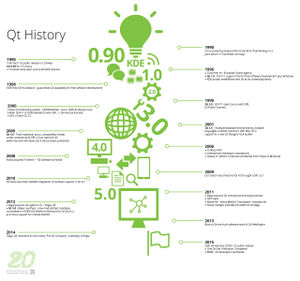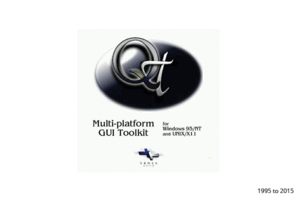About Qt
Jump to navigation
Jump to search
What is Qt?
- framework
- cross-platform
- application development
- C++, extensions with MOC
- GUIs in QML (QtQuick) or XML (QWidgets)
- Desktop, embedded, mobile: Linux, OS X, Windows, VxWorks, QNX, Android, iOS, BlackBerry, Sailfish OS,..., see Supported Platforms
- Bindings to other programming languages, e.g. to Python using PyQt
- Qt is owned by The Qt Company (wholly owned subsidiary of Digia Plc., Finland)
- The Qt Governance Model
- Developed by many parties (see stats)
- Different licenses: Multiple commercial licenses, LGPL, GPL, see: Licensing FAQ
- superb documentation
- Brings own IDE (Qt Creator) for Linux, OS X and Windows; code completion, syntax highlighting, integrated help system, debugger and profiler integration, integration for all major version control systems, GUI designer
- Brings add-in for Microsoft Visual Studio
- Other IDEs can be used
- Brings additional tools like build system (qmake, other build systems like cmake also supported) and internationalization tools
Statistics
- 1 million downloads of Qt 5.3 measured just over a month after launch.[1]
- 250+ commits by 60+ contributors per week[2]
- Leading companies in over 70 industries use Qt to power millions of devices and applications.[3]
- Main companies contributing to Qt in 2015[2]:
- The Qt Company (Finland)
- KDAB (Sweden)
- AudioCodes (Israel)
- Intel (USA)
- Intopalo (Finland)
- Jolla (Finland)
- BlackBerry (Canada)
- Woboq (Germany)
- Service partners of The Qt Company[4]:
- Technology partners[4]:
- Adeneo Embedded (France)
- ARM (UK)
- Boundary Devices (USA)
- Freescale Semiconductor (USA)
- froglogic (Germany)
- SILICA (Germany)
- Texas Instruments (USA)
- Toradex (Switzerland)
- V-Play (Austria)
- Community partners[4]:
History
- “In the summer of 1990, Haavard [Nord] and Eirik [Chambe-Eng] were working together on a C++ database application for ultrasound images. The system needed to be able to run with a GUI on Unix, Macintosh, and Windows. One day that summer, Haavard and Eirik went outside to enjoy the sunshine, and as they sat on a park bench, Haavard said, “We need an object-oriented display system.” The resulting discussion laid the intellectual foundation for the object-oriented cross-platform GUI framework they would soon go on to build.”[5]
- Release history
References
- ↑ http://www.digia.com/en/Company/News/Digia-Announces-The-Qt-Company-Launches-a-Unified-Website-and-Unleashes-a-20-Indie-Mobile-Monthly-Subscription-Plan/
- ↑ 2.0 2.1 Thiago Macieira's blog
- ↑ http://www.qt.io/qt-in-use/
- ↑ 4.0 4.1 4.2 https://www.qt.io/partners/
- ↑ Blanchette, J & Summerfield, M. (2006). C++ GUI Programming with Qt 4. Prentice Hall.

